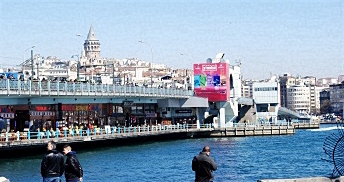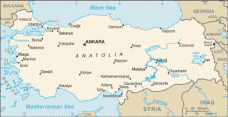Istanbul Cruise Ship Destination Port
Cruise Ship Port of Call information like Port News, Weather, Transportation Options, Things to Do and See, Area Events, Medical Care, Crime and Safety Review
Venice
Get to know our slice of Paradise - located on the SW Coast of Fl.
Attractions
Beaches
Canoe/Kayak
Boat Launches
Boat Charters
Fishing Charter
Fishing Piers
Historical Sites
Golf
Parks
Hotels
Relocate
Venice Map
Getting Around
Taxis
Taxis are plentiful in Istanbul and are more likely to hail you than vice versa. Avoid taxis that congregate around the main tourist spots like Topkapi Palace, Aghia Sofia, and at the cruise ship landing in Karaköy - these are the ones adept at confusing tourists with the umber of zeros on banknotes. Hail a cab on the main streets or when out and about, pop into the nearest hotel and have the receptionist call a taxi for you. A taxi from Taksim to the port will cost around 4-5 Euros depending on traffic, while night time rates are slightly higher. A taxi from the Cruise Ship Port to the Grand Bazaar should cost no more than 8 Euros. Prices subject to change. Updated March 2012.
Bus
Metro buses in Istanbul are frequent, comprehensive, and economical. The final destination of the bus is indicated above the front windshield , with a selection of major stops listed on the side of the bus next to the entrance, not much help if you aren't familiar with the basic layout of the city. Always check with the driver before getting on to make sure the bus is going in the direction you need.
The Dolmus
The main dolmus stands are located in Taksim, Sirkeci and Aksaray, and connect to points all over the city. Dolmuses are often more direct than metropolitan buses and cheaper than taxis. When boarding, tell the driver your destination, and ask how much it will be (ne kadar?)
ports > destinations > Istanbul
Istanbul,Turkey

Istanbul (formerly Constantinople) is the capital of Istanbul Province, and the most populated city in Turkey. Istanbul is historically important as the capital first of the Byzantine Empire and later of the Ottoman Empire. In its influence on the development of Roman law, Greek philosophy and art, and Christian theology and on church history, Byzantine-ruled Istanbul rivaled the cultural contributions of Athens, Jerusalem, Rome, and Paris.
Istanbul is also notorious as one of the most frequently besieged cities in the world. Before the Turkish conquest its assailants included the Arabs, the Bulgarians, and the armies of the Fourth Crusade, which twice succeeded in taking the city. After Constantinople fell to the Turks in 1453, the city became the capital of the Ottoman, or Turkish, Empire; it was the capital of present-day Turkey until 1923, when the newly founded Turkish Republic declare Anakara (then Angora) the capital. From 1918 until 1923 Britain, France and Italy occupied the city. The name was official changed to Istanbul in 1930.
Need to Know
Natural Hazards
Turkey is prone to severe earthquakes, especially in northern Turkey, along an arc extending from the Sea of Marmara to Lake Van.
Latest Seismic Activity in Turkey (link from Bogazici University and the Kandilli Observatory and Earthquake Research Institute.)
International Relations
Turkey is in a strategic location controlling the Turkish Straits (Bosporus, Sea of Marmara, Dardanelles) that link Black and Aegean Seas. Complex maritime, air, and territorial disputes continue with Greece in Aegean Sea; Cyprus question with Greece; dispute with downstream riparian states (Syria and Iraq) over water development plans for the Tigris and Euphrates rivers; traditional demands regarding former Armenian lands in Turkey have subsided; Turkey is quick to rebuff any perceived Syrian claim to Hatay province; border with Armenia remains closed over Nagorno-Karabakh dispute.
Good to Know
Port of Entry
The port of Istanbul is the most important one in the country. The old port on the Golden Horn serves primarily for personal navigation, while Karaköy port in Galata is used by the large cruise liners. Regular services as well as cruises from both Karaköy and Eminönü exist to several port cities in the Mediterranean Sea and Black Sea. Istanbul's main cargo port is located in the Harem district on the Asian side of the city.
Climate
Istanbul has a humid subtropical climate - hot, dry summers with mild, wet winters; harsher in interior.
Time Zone
Eastern European Time (+2 GMT, +6 EDT) Eastern European Summer Time (+3 GMT). Summer time begins the last Sunday in March and ends on the last Sunday of October.
National Holiday
Independence Day, 29 October (1923).
Language
Turkish (official), Kurdish, Arabic, Armenian, Greek
Religions
Muslim 99.8% (mostly Sunni), other 0.2% (mostly Christians and Jews). Mount Ararat, the legendary landing place of Noah's Ark, is in the far eastern portion of the country.
Things to do and see
Hagia Sophia
Hagia Sophia is a former Orthodox patriarchal basilica, later a mosque, and now a museum in Istanbul, Turkey.
From the date of its dedication in 360 until 1453, it served as the Greek Patriarchal cathedral of Constantinople, except between 1204 and 1261, when it was converted to a Roman Catholic cathedral under the Latin Patriarch of Constantinople of the Western Crusader established Latin Empire. The building was a mosque from 1453 until 1931, when it was secularized. It was opened as a museum on in February 1935
Sultan Ahmed Mosque
The mosque is popularly known as the Blue Mosque for the blue tiles adorning the walls of its interior. It was built from 1609 to 1616, during the rule of Ahmed I. Like many other mosques, it also comprises a tomb of the founder, a madrasah and a hospice. While still used as a mosque, the Sultan Ahmed Mosque has also become a popular tourist attraction.
The design of the Sultan Ahmed Mosque is the culmination of two centuries of both Ottoman mosque and Byzantine church development. It incorporates some Byzantine elements of the neighboring Hagia Sophia with traditional Islamic architecture and is considered to be the last great mosque of the classical period.
Hamam
A significant culture has been developed around what is known as a Hamam,, the Turkish word for a Turkish Bath. It was a culture of leisure during the Ottoman period, one of the finest example being the Çemberlitaş Hamamı (1584) in Istanbul, located on the Çemberlitaş (Column of Constantine) Square.
Shopping
The Grand Bazaar
The Grand Bazaar in Istanbul is one of the largest and oldest covered markets in the world with 61 covered streets and over 3,000 shops which attract between 250,000 and 400,000 visitors daily. grandbazaaristanbul.org









